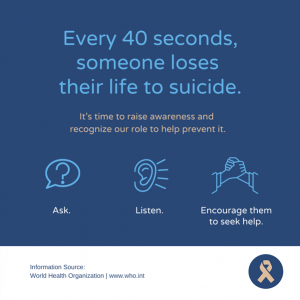Suicide Prevention Handbook
Approximately 800,000 people die by suicide every year, one person dies every 40 seconds. The World Health Organization’s (WHO) first report on suicide prevention, Preventing Suicide: A Global Imperative, states that suicide is a global phenomenon occurring in all regions of the world. Suicide was the second leading cause of death among the 15-29 age group globally in 2016. But, behind these alarming numbers, remember that suicide is preventable! This article will hopefully help you and the family and friends around you recognize the signs of suicide and the methods that can help.
Image Source: Sandaki.com
What you need to know about suicide
- Nearly 800,000 people die by suicide every year.
- The number of attempted suicides is many times greater than the number of deaths by suicide each year.
- Every year more men than women die by suicide. In wealthy countries, men die by suicide three times as often as women, and men aged 50 and older are more vulnerable.
- In low- and middle-income countries, suicide rates are higher among young adults and older women than among their counterparts in high-income countries, and women over age 70 are more than twice as likely to die by suicide as women aged 15-29.
- In 2016, low- and middle-income countries accounted for over 79% of global suicides.
- The most common means of suicide globally are drinking pesticides, hanging, and using firearms.
Misunderstandings about suicide
1. If I ask someone around me if they have any suicidal thoughts, will it trigger them to commit suicide?
This is a very important issue and one of the biggest misconceptions the public has about suicide prevention. If you don’t have time to read this article all the way through, just remember one thing: no research proves that discussing suicide will trigger suicide. Asking the person if they have suicidal thoughts and discussing them further is one of the best things you can do to prevent suicide.
2. Some people say that suicide is just lip service and that they will not actually commit suicide.
Most people who commit suicide have hinted to a friend or loved one that they are going to kill themselves before they do so. So don’t take any sign of suicide lightly. Whether it sounds like a joke or a casual remark, it’s a sign to ask for help.
3. Suicide is a sign of cowardice and selfishness, lack of respect for life, and lack of consideration for family members.
Such an idea is a misconception about suicide at a societal level. Different people have different reasons for committing suicide, but in most cases, they can no longer bear the pain of life and believe that suicide is the only way to stop hurting at the moment.
The process of suicide torments even the most desperate and depressed people, whether to choose life or death? Sometimes it’s a matter of thought, and this tangled process provides the window for intervention. Who has not experienced a certain stage of darkness and helplessness in their lives?
4. People who want to commit suicide cannot be stopped?
An article, Why must we stop people who want to commit suicide, trended on social media. Written by a netizen who once tried to commit suicide and fortunately was prevented by his brother, who came home early.
She is 5’7” tall, has been practicing tennis for ten years, is a national-level athlete, and has a privileged and smooth life. Unfortunately, a car accident killed her boyfriend and left her with a lifelong disability in her left arm (she is left-handed), so she had to practice again to dress and eat. She was so despondent that she thought of suicide.
“The moment I drank the pesticide, I regretted it, and luckily, my brother, who had originally planned to take the train, flew home early.”
“When you want to kill yourself, no matter what way you use, at the moment you put it into action, you will regret it. It’s at that moment you understand we can solve any problem, but by then it is too late.” She uses her personal experience to tell people they must stop suicide because the moment they commit suicide, they will all regret it.
How to identify suicide signals
As we mentioned in this article, in most cases, a person who plans to commit suicide will release suicide signals before committing suicide. Then, how to recognize these suicide signals also becomes the most important step in suicide prevention.
We have summarized the following ten signs of suicide from the American Psychological Association and the Help Guide organization.
- Verbal or written expressions of intent to commit suicide. For example, I wish I had never been born; I don’t want to live; I want to disappear; I want to jump from some high place, etc.
- Collect or think about suicide tools, such as guns, pills, knives, etc.
- A sudden personality change: for example, a calm personality suddenly becomes tyrannical, a lively one suddenly becomes silent, etc.
- Stay away from family and friends and close themselves off.
- Start writing their last wishes, give away their precious things, and make other arrangements for their family.
- Increased self-injurious behavior. Although self-harm is not the same as suicide, increased self-harm behaviors, such as car racing, excessive alcohol consumption, and reckless and impulsive behavior without regard to risk, are sometimes signs of suicide.
- Suddenly becoming unusually calm. A sudden calm after a long period of depression is sometimes a final decision to commit suicide after already struggling.
- Changes in diet and sleep.
- A sense of helplessness and lack of hope for the future are one of the biggest signs of suicide.
- Increased loneliness on important holidays or anniversaries (death anniversary of a loved one, etc.). For example, in the United States, major holidays such as Thanksgiving and Christmas increase loneliness, which may trigger suicide.
How to communicate with suicidal people?
Ideally, it is most effective and reliable to seek professional help if you are suicidal. Some studies show that 70% of suicides occur at home. What is the first step we can take as friends or family members?
A reader who has experienced suicidal tendencies with a close friend or family member may have wondered: What if my judgment is wrong? Maybe I’m overthinking it and he or she may not be trying to kill himself or herself? What if he or she is angry with me if I ask? These are, of course, all very natural tangles and worries.
However, the most important rule of suicide intervention is the sooner, the better! You need to keep in mind that your concern and questioning will not lead to suicide, but is a valuable opportunity for you to show your concern and help the person. We suggest you might begin your inquiry by asking the following questions:
“I’ve been concerned about you lately. Are you okay?”
“You seem to have changed a bit lately, and I wanted to ask you how you are doing?”
“You don’t look much like yourself. Can we talk?”
Next, you can ask further questions like this:
“When did you first notice these changes in yourself?”
“Can you let me help you? Tell me, what do you need my help with?”
Some language has proven to be comforting to suicidal friends, for example:
“I’ll be there when you need me. You’re not alone!”
“I may not fully understand what you’re going through. But I care about you, and I want to help you!”
We recommend you listen more and remember that even if you have experienced no training in counseling, your concern for a person is the most helpful thing you can do. We do not recommend doing the following things:
- Arguing with a suicidal person.
- Not to act too surprised. Such an attitude may prevent the person from sharing further.
- Not rushing to help with specific problems.
We can prevent suicide. Scientific knowledge and the right attitude are important forces in preventing suicide.
Author’s Bio: My name is Carl Lee, and I have a Master’s degree in Psychology. I have been working in the mental health field since I graduated. Our company website, www.sandaki.com, is also a platform for people to share their stories about depression and anxiety.
This article was published with the permission and cooperation of JosephBinning.com.
Carl Lee is a guest contributor to JosephBining.com.
Because we strongly believe that all life matters and is important we thought it appropriate to share this important message.


0 comments